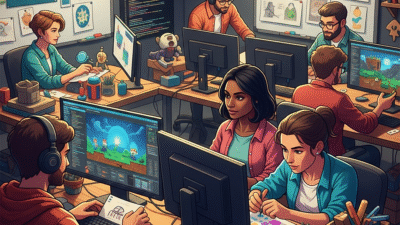Discover what lies ahead for game development in 2025 as we explore the latest trends, technologies, and tools revolutionizing the industry. From AI-driven design and procedural content generation to real-time ray tracing, cloud gaming, and the evolution of game engines like Unreal Engine 5 and Unity, this blog provides deep insights into how developers are adapting to an ever-changing landscape.
Learn how AR/VR, blockchain, and cross-platform experiences can reshape gameplay and player engagement. Whether you’re an indie developer, seasoned studio, or tech enthusiast, understanding these innovations is key to staying ahead in the rapidly evolving world of game development.
Table of Contents:
- Introduction
- Evolution of game engines (Unreal 5, Unity, Godot)
- AI and ML in NPC behavior and content generation
- Cross-platform and cloud-based gaming
- AR/VR integration in mainstream games
- The role of blockchain and NFTs in game ecosystems
- Indie vs AAA: How the dev landscape is shifting
- Essential tools & stacks for modern dev workflows
- Conclusion
1. Introduction
- The video game industry is undergoing a seismic transformation in 2025, powered by rapid technological advancements and shifting player expectations. Once dominated by consoles and high-end PCs, the modern gaming landscape now spans cloud platforms, AR/VR headsets, mobile devices, and even decentralized ecosystems.
- Game developers today are no longer just coders or artists. They are engineers, storytellers, data scientists, and innovators navigating an incredibly complex but rewarding environment.
- In this blog, we’ll explore the cutting-edge trends and tools redefining game development in 2025. From AI-generated worlds and photorealistic graphics to cloud-native architecture and player-personalized experiences, the future of game development is not only bright is blazing. Whether you’re an indie developer, a seasoned studio lead, or an aspiring designer, understanding the technological and creative forces at play is crucial to staying competitive and inspired.
- Join us as we dive into the future of game creation, which is one shaped by real-time rendering, intelligent systems, and a global player base that demands more than ever before.
2. Evolution of game engines (Unreal 5, Unity, Godot)
Game engines are the heart and soul of modern game development. They dictate the boundaries of visual fidelity, physics, AI behavior, scalability, and cross-platform deployment. In 2025, the evolution of game engines has accelerated to meet the growing complexity and diversity of platforms, from photorealistic AAA experiences to stylized indie masterpieces and even fully immersive AR/VR worlds.
Three engines continue to dominate the conversation: Unreal Engine 5, Unity, and the increasingly popular Godot. Each serves different tiers of developers but is rapidly adapting to the future of gaming, thanks to new workflows, rendering pipelines, and integration with advanced technologies.
Unreal Engine 5: Redefining Photorealism and Real-Time Rendering
1) Lumen and Nanite: Realism Made Simple
Unreal Engine 5 (UE5) introduced two groundbreaking technologies: Lumen, a fully dynamic global illumination system, and Nanite, a virtualized geometry system that handles film-quality assets with minimal performance cost. In 2025, these technologies have matured further, offering even better performance on mid-tier hardware and expanding support for mobile and VR platforms.
These innovations allow developers to:
- Skip traditional light baking entirely.
- Import film-quality 3D assets without manual optimization.
- Create open worlds with unprecedented realism.
2) World Partition & Procedural Content
UE5’s World Partition system lets developers build expansive, seamless open worlds by automatically managing level streaming. Combined with new procedural content generation tools, developers can now generate complex ecosystems in forests, cities, and cave systems with minimal handcrafting.
3) Metahuman Integration
Epic’s Metahuman Creator is now tightly integrated with UE5, allowing developers to build lifelike digital characters in a fraction of the time it used to take. Metahumans now support full facial animation, mocap syncing, and LOD optimizations for scalable performance across devices.
Unity: Cross-Platform Mastery and Creator-Centric Tools
1) Unity 2023–2025 Roadmap
Unity’s evolution in the past two years has focused on performance, modularity, and creator tools. With DOTS (Data-Oriented Tech Stack) becoming more mainstream, Unity games now achieve better performance on low-end hardware while maintaining scalability across devices, including AR/VR.
2) URP & HDRP: Specialized Pipelines
Unity has refined its Universal Render Pipeline (URP) for mobile and cross-platform titles and its High-Definition Render Pipeline (HDRP) for high-end visuals. These pipelines now include more out-of-the-box VFX, lighting, and shadow options making it easier to switch between mobile and desktop targets.
3) Unity Sentis & Muse (AI Integration)
Unity’s recent tools, Sentis (for AI inference on devices) and Muse (for content generation) are giving developers creative superpowers. Sentis brings machine learning models to runtime environments, while Muse lets artists auto-generate textures, animations, or NPC logic with natural language prompts.
4) Unity Cloud and Multiplayer Services
Unity’s acquisition of backend services like Multiplay, Vivox, and Game Server Hosting has matured into a full-stack cloud ecosystem. Developers can now handle voice chat, matchmaking, server scaling, and analytics within Unity’s built-in tools.
Godot Engine: Open-Source Power for Indie Innovation
1) Godot 4.x: Full 3D and Vulkan-Powered
Godot has seen a massive leap with the release of Godot 4.x, bringing a brand-new Vulkan renderer, real-time global illumination, and dramatically improved 3D performance. Once seen as primarily a 2D engine, Godot now supports:
- Full-featured 3D environments
- Shader Graphs and visual scripting
- Real-time shadows and PBR workflows
2) Lightweight and Modular
Godot’s open-source nature makes it perfect for developers who want full control. Its lightweight footprint, custom build options, and platform-agnostic deployment have made it a favorite for:
- Indie devs building pixel art games
- Educational institutions and researchers
- Studios that need a fully white-label engine
3) GDScript & C# Integration
Godot’s native scripting language, GDScript, is fast and beginner friendly. However, developers can now also use C#, C++, and Rust with official support, making the engine highly adaptable for performance-critical projects.
3. AI and ML in NPC behavior and content generation
Artificial Intelligence (AI) and Machine Learning (ML) are no longer niche technologies in game development. They are core to the next generation of immersive, dynamic, and personalized gaming experiences. In 2025, developers are leveraging AI not just to enhance NPC (non-player character) behavior but also to generate content, manage balancing, and adapt gameplay to individual players. The result? Games that feel more alive, responsive, and unpredictable, where every player’s experience can be truly unique.
Let’s explore how AI and ML are revolutionizing both NPC behavior and content generation, two of the most dynamic frontiers in modern game design.
Smarter NPCs: Beyond Scripting to True Simulation
Traditionally, NPC behavior was rule-based and driven by finite state machines or behavior trees. While effective, these systems often lead to predictable and repetitive behavior. AI and ML are changing this in profound ways:
1) Reinforcement Learning (RL) for Adaptive NPCs
- Combat AI learns to flank, retreat, or anticipate player patterns.
- Social AI evolves based on dialogue choices or moral decisions.
- Animal behaviors change dynamically with ecosystem or player disruption.
2) Emotional and Social AI
- Emotive interactions that change based on tone, dialogue history, and trust.
- Social networks among NPCs (seen in games like Watch Dogs: Legion), where relationships impact gameplay (e.g., an enemy’s friend might seek revenge later).
3) Large Language Models (LLMs) for NPC Dialogue
- NPCs can respond intelligently to open-ended player input.
- Quest lines can evolve naturally based on conversation paths.
- Localized responses become more context-aware and culturally nuanced.
In 2025, games like Inworld Origins and experiments using ChatGPT-powered NPCs are laying the groundwork for natural language-driven storytelling.
Procedural Content Generation (PCG) Using AI
AI is not just limited to character behavior; it is actively shaping game worlds, quests, levels, and even art assets.
1) Quest and Narrative Generation
- Automatically generate side quests with meaningful story arcs.
- Adapt narratives based on the player’s choices and progression style.
- Create branching dialogue trees that evolve dynamically during gameplay.
2) Level Design and World Generation
- Neural networks trained on existing level data can create balanced and thematic maps.
- AI-generated terrain, dungeons, or cities feel hand-crafted yet infinitely variable.
- Tools like Promethean AI assist level designers by placing assets based on intent (“make this room feel abandoned”) rather than manual drag-and-drop.
3) AI-Assisted Game Art and Audio
- High-quality textures or environmental concepts based on developer prompts.
- Voice synthesis that sounds natural and can adapt to various tones or languages.
- Music those changes based on in-game events or emotions using ML-driven composition tools like AIVA or Amper Music.
4. Cross-platform and cloud-based gaming
In 2025, gaming is no longer be confined by hardware limitations or platform boundaries. The rise of cross-platform experiences and the expansion of cloud-based gaming have unlocked entirely new ways for players to engage, compete, and collaborate whether they’re on consoles, PCs, mobile devices, or even smart TVs.
For developers, this evolution presents both incredible opportunities and significant technical challenges. Building a fragmented ecosystem now requires smart architectural decisions, scalable infrastructure, and a deep understanding of user expectations.
This section explores the tools, technologies, and best practices that power cross-platform and cloud-native gaming in today’s ecosystem and what developers must master to stay ahead.
The Rise of Cross-Platform Gaming
Cross-platform gaming is no longer an industry luxury is a player expectation. Whether it’s casual puzzle games or competitive shooters, users want to play with friends regardless of device.
1) What Cross-Platform Means Today
Cross-platform support includes:
- Cross-play: Real-time multiplayer across platforms (e.g., PC vs console).
- Cross-progression: Shared save data and achievements across devices.
- Cross-purchase: Buy once, play anywhere (linked accounts, cloud saves).
2) Technical Requirements
Achieving true cross-platform functionality involves:
- Unified account systems (Epic, Xbox Live, PlayFab, custom OAuth)
- Cloud saves and syncing (Firebase, AWS S3, Unity Cloud Save)
- Input parity and matchmaking adjustments to balance keyboard/mouse vs controllers or touch input
- Platform-specific optimization (especially on mobile vs console/PC)
3) Game Engines Leading the Way
Modern engines like Unreal Engine 5, Unity, and Godot 4.x offer built-in tools for cross-platform packaging:
- Single codebase deployment to PC, iOS, Android, Xbox, PlayStation, WebGL, etc.
- Auto-adjusting graphical settings via device profiling
- Modular input systems that support multi-device configurations
Cloud-Based Gaming: Game Streaming and Remote Rendering
Cloud gaming allows players to run high-end games on low-power devices by offloading processing to powerful servers and streaming video output to the end-user. In 2025, this model is becoming mainstream, fueled by faster internet, edge computing, and infrastructure investments from major tech firms.
1) Leading Cloud Gaming Platforms
- Xbox Cloud Gaming (xCloud): Full Game Pass library available on mobile, TV, and browser.
- NVIDIA GeForce NOW: Lets users stream their own PC libraries (Steam, Epic Games) from NVIDIA’s cloud servers.
- Amazon Luna and PlayStation Cloud: Cloud-first game access.
- Shadow and Parsec: For remote PC-based game rendering and dev workflows.
2) Benefits for Developers
- Lower barrier to entry: Players don’t need expensive hardware.
- Easier game trials: Streaming demos without full downloads.
- Expanding reach: Gamers in low-income or infrastructure-limited regions can now access AAA titles.
3) Architectural Requirements
Cloud-native games often involve:
- Remote rendering pipelines: GPUs render frames server-side and stream via WebRTC.
- Latency minimization techniques: Predictive input modeling, frame pacing, and edge server routing.
- Session persistence: It is state sync across cloud and local sessions.
- Server-side anti-cheat: Reduces tampering risk when logic is executed remotely.
Cloud-Native Game Development
Unlike traditional titles, cloud-native games are built from the ground up to live in the cloud designed for scalability, persistence, and service-oriented architecture.
1) Key Characteristics
- Persistent worlds that evolve even when players log off.
- Dynamic scalability for events like live concerts (Fortnite), esports, or community content.
- Microservices architecture for modular game logic (e.g., chat, inventory, matchmaking).
2) Backend-as-a-Service (BaaS) Providers
Developers can now lean on BaaS platforms for cloud-native development:
- Microsoft Azure PlayFab: Scalable backend with user authentication, leaderboards, live ops tools.
- Amazon GameLift: Game server hosting with automatic scaling and health checks.
- Unity Game Server Hosting (Multiplay): Rapid deployment across data centers.
- Beamable and Nakama: Open-source options for indie and mid-sized studios.
3) DevOps and CI/CD for Games
Modern cloud development encourages:
- Automated build pipelines and testing (Jenkins, GitHub Actions, Unity Cloud Build)
- Continuous updates and A/B testing of features
- Remote logging and telemetry for real-time debugging

5. AR/VR integration in mainstream games
In 2025, Augmented Reality (AR) and Virtual Reality (VR) are no longer niche experiences tucked away in experimental titles or indie showcases. Instead, they are increasingly becoming part of mainstream game development, supported by mature hardware, robust development tools, and a growing user base. As immersion becomes a key competitive advantage, AAA studios and indie devs alike are weaving AR and VR elements into their design pipelines.
This section explores the current landscape of AR/VR in gaming, how developers are integrating immersive tech into popular titles, the tools and engines enabling this transition, and what challenges remain in making XR (Extended Reality) the new norm.
The State of AR and VR in 2025
1) Market Growth and User Base
- Over 200 million active VR headset users globally, fueled by standalone, affordable devices like the Meta Quest 3, Apple Vision Pro, and Sony PlayStation VR2.
- AR adoption is accelerating with smart glasses, mobile AR, and mixed-reality headsets used for both games and productivity.
- Increasing crossover between mobile AR users (e.g., Pokémon GO) and VR gamers players now expect cross-device XR experiences.
2) Hardware Innovation
- Meta Quest 3 and Apple Vision Pro bring high-fidelity graphics, room-scale tracking, eye tracking, and hand gesture input.
- Lightweight AR glasses (e.g., XREAL Air 2, Rokid, Magic Leap 2) are being designed with consumer-first aesthetics and mobile-first integration.
- Haptic feedback suits, gloves, and spatial audio setups are enabling richer presence in VR.
AR/VR in Mainstream Game Titles
AR and VR are now being used to extend, enhance, or reinvent mainstream titles rather than serve as stand-alone novelties.
1) VR Remakes of Popular Franchises
- Resident Evil 4 VR, Half-Life: Alyx, and Skyrim VR have shown how legacy titles can be reimagined with full immersion.
- Gran Turismo 7 VR and No Man’s Sky VR offer hybrid experiences: playable both traditionally and in VR, with seamless transitions.
2) AR in Companion Experiences
- Call of Duty: Mobile AR features gun-skin previews and real-time strategy overlays through smartphone cameras.
- AR apps linked to console games (e.g., Cyberpunk 2077, Elden Ring) enable map viewing, lore exploration, and object interaction in the real world.
3) Social and Competitive XR Experiences
Rec Room, VRChat, and Roblox’s AR/VR integration are fostering cross-platform, user-generated social spaces.
Esports in VR (Echo VR, Population: ONE) are pushing immersive multiplayer into mainstream tournament scenes.
Game Engines and Tools Supporting XR Development
Developers in 2025 have powerful toolsets to bring AR and VR experiences to life, often from a shared project base.
1) Unity XR Toolkit
- Supports building and deploying to multiple XR platforms (Quest, Vision Pro, Steam VR, Android ARCore, and Apple ARKit).
- Provides input abstraction, spatial mapping, gesture recognition, and mixed-reality passthrough support.
- Unity MARS adds AI-driven object detection and behavior templates for AR use cases.
2) Unreal Engine 5
- With Nanite and Lumen, UE5 enables photorealism in VR environments while maintaining high frame rates.
- Built-in support for headsets like PSVR2, Quest 3, and Vision Pro.
- VR Template now includes teleportation, hand-tracking, and performance tuning out of the box.
3) WebXR and OpenXR
- OpenXR standardizes cross-device XR support, making it easier to build once and support many platforms.
- WebXR APIs allow for lightweight AR/VR games that run directly in browsers critical for mobile and educational gaming.
6. The role of blockchain and NFTs in game ecosystems
The rise of blockchain and non-fungible tokens (NFTs) has redefined the conversation around ownership, interoperability, and monetization in modern gaming. While these technologies sparked controversy during their early hype cycles, by 2025, they’ve matured into powerful infrastructure components that many games quietly rely on. From digital asset ownership to decentralized economies and smart contract-enabled game logic, Blockchain is subtly but steadily reshaping the gaming experience for developers, players, and publishers alike.
This section unpacks the actual value (and challenges) of blockchain and NFTs in gaming, the tools supporting their integration, and how developers are leveraging Web3 elements responsibly.
Understanding Blockchain in Gaming
At its core, blockchain is a distributed, immutable ledger. In gaming, this has several direct applications:
1) Digital Ownership
- Players can truly own in-game items, characters, land, or currencies — not just lease them from game servers.
- Assets are recorded on-chain, making them tradable, sellable, and usable outside the original game (if allowed by design).
2) Transparent Economies
- Blockchain introduces verifiable scarcity and decentralized marketplaces, allowing peer-to-peer trade without reliance on game publishers.
- Price histories, origin (provenance), and transaction logs are fully transparent.
3) Smart Contracts
- Automated game mechanics (e.g., loot generation, quest rewards, and staking mechanisms) can be implemented through smart contracts, ensuring trustless interaction.
NFTs: Tokenizing Game Assets
NFTs (non-fungible tokens) represent unique digital items, differentiated from cryptocurrencies like Bitcoin (which are fungible).
1) What Can Be an NFT in a Game?
- Characters or avatars with unique traits
- Weapons, skins, armor, or vehicles with rarity or customizability
- Virtual land in metaverse-style environments
- Game achievements, titles, or badges
2) NFT Standards Used in Games
- ERC-721 and ERC-1155 (Ethereum) are common standards for NFTs.
- Tezos, Solana, Immutable X, Polygon, and Aptos offer cheaper, greener alternatives to Ethereum with gaming-oriented ecosystems.
Real-World Examples of Blockchain Gaming in 2025
By now, the first wave of “Play-to-Earn” (P2E) games has largely faded, replaced by Play-and-Own or Reward-enhanced gameplay systems with actual gameplay value.
1) Axie Infinity (Evolved)
Once a P2E trailblazer, it now focuses on long-term engagement, creature breeding, and interoperable NFT ecosystems.
2) Illuvium
An open-world RPG and auto-battler that uses NFTs for characters and arenas playable across Ethereum and Immutable X.
3) Gods Unchained
A competitive card game where each card is an NFT. Players trade, sell, and build decks from assets they truly own.
4) The Sandbox & Decentraland
Virtual worlds where land parcels, avatars, wearables, and even experiences (concerts, stores, games) are tokenized and monetized.
Development Platforms and Toolkits
Game developers no longer need to be crypto experts to integrate blockchain functionality.
1) Blockchain SDKs for Game Engines
- Unity Web3 SDKs: Provided by Moralis, Thirdweb, and ChainSafe, allowing wallet integration, NFT minting, and blockchain calls within Unity.
- Unreal Engine plugins: Web3-ready integrations for asset minting, wallet connect, and smart contract interaction.
2) Web3 Game Dev Platforms
- Thirdweb: No-code and low-code tools for NFT drops, smart contracts, and game logic integration.
- Immutable X: Layer-2 Ethereum solution purpose-built for game NFTs with zero gas fees, carbon-neutral, and instant transaction finality.
- Enjin: Offers wallet infrastructure, NFT creation, and a platform for multiverse items across games.
- Flow by Dapper Labs: Designed for games and collectibles (used in NBA Top Shot, CryptoKitties).
3) Wallets and Onboarding UX
- MetaMask, Phantom, and WalletConnect allow login and asset management.
- UX tools like Magic.Link or Sequence simplify onboarding for non-crypto-native players via social or email login.
Benefits to Game Developers and Publishers
1) New Revenue Streams
- Minting and trading NFTs can create secondary marketplaces with royalty enforcement (e.g., 5% resale of royalties to developers).
- Limited edition items, skins, or virtual merchandise drop campaigns can generate scarcity-based revenue.
2) Community Engagement
- Blockchain can power governance systems where players vote on game changes.
- NFT ownership may confer access to special content, events, or tournaments.
3) Cross-Game Portability
- Interoperable assets can function across multiple titles, especially within shared universes or publisher ecosystems (e.g., Ubisoft Quartz).
7. Indie vs AAA: How the dev landscape is shifting
The traditional divide between indie game developers and AAA studios will become increasingly blurred in 2025. What used to be a question of budget, team size, and distribution reach is now a more complex interplay of technology access, player expectations, funding models, and community-driven innovation.
As tools become more democratized and digital distribution levels the playing field, indie creators are delivering experiences that rival AAA productions in quality, while AAA studios are borrowing indie sensibilities to stay agile, creative, and culturally relevant.
In this section, we’ll explore the evolution of indie and AAA game development, how their roles are changing in the industry, and what the shifting power dynamics mean for the future of gaming.
Defining Indie vs AAA in 2025
AAA Game Studios
- High budget ($50M+), high-risk projects are often developed by hundreds of staff.
- Examples: Rockstar Games (GTA), Naughty Dog (The Last of Us), CD Projekt Red (Cyberpunk), Ubisoft, EA, Activision.
- Prioritize large-scale graphics, open worlds, cinematic storytelling, and mass-market appeal.
Indie Developers
- Small teams (sometimes solo developers) with limited budgets often rely on self-publishing or crowdfunding.
- Examples: Concerned Ape (Stardew Valley), Team Cherry (Hollow Knight), Supergiant Games (Hades), and ZA/UM (Disco Elysium).
- Focus on innovation, niche gameplay, personal storytelling, or experimental mechanics.
The Middle Ground: AA and Boutique Studios
- Mid-sized teams produce high-quality, story-driven or stylized games without AAA budgets or pressures.
- Examples: Ninja Theory, Larian Studios, Dontnod, and Moon Studios.
- AA space is growing rapidly, often acting as a bridge between indie creativity and AAA production values.
Democratization of Tools and Engines
Game Engines: Leveling the Playing Field
- Unreal Engine 5, Unity, and Godot 4 are now fully accessible to indie devs with free or low-cost licenses.
- Features like Nanite (micro-polygon rendering), Lumen (dynamic lighting), and Unity’s URP/HDRP enable AAA-quality visuals without a massive team.
Marketplace Ecosystems
- Indie devs rely on asset stores, code plugins, animation packs, and audio libraries to prototype quickly.
- Tools like Quixel Megascans, Mixamo, and Artbreeder empower solo creators to build production-ready assets affordably.
Cloud-Based Collaboration
- Platforms like GitHub, Perforce Cloud, and Unity Cloud Build make remote team management viable for indies.
- Real-time co-development tools allow geographically distributed indie teams to function like professional studios.
Funding Models: From Publishers to Platforms to Players
Crowdfunding
- Sites like Kickstarter, Fig, and Gamefound remain vital for indie devs to fund early development while validating demand.
- Successful examples include Sea of Stars, Eiyuden Chronicle, and Hollow Knight: Silksong.
Venture Capital & Incubators
- More VCs and accelerators (e.g., Kowloon Nights, Indie Fund) are investing in indie studios for a share of IP or long-term equity.
Platform Grants & Deals
- Microsoft’s ID@Xbox, Epic’s MegaGrants, and Valve’s Steam Labs have empowered indies to launch faster with reduced risk.
- Subscription-based deals (e.g., Game Pass, PlayStation Plus) provide upfront revenue and marketing exposure.
NFT and Web3 Models
Some indie studios experiment with blockchain-based funding or early access through token sales, though adoption is more cautious post-2022.
Distribution & Discovery: The Platform Revolution
Steam and Epic Games Store
- Steam continues to dominate, but its discoverability algorithm heavily influences indie success.
- Epic offers higher revenue splits (88/12 vs Steam’s 70/30), enticing more indie devs.
Console & Mobile Democratization
- Nintendo Switch and Steam Deck have become indie havens due to supportive publishing policies.
- Mobile markets (Apple Arcade, Google Play Indie Showcase) are helping unique games reach new audiences.
Cloud Gaming
- Platforms like GeForce NOW, Xbox Cloud Gaming, and NVIDIA’s RTX Remix allow even low-powered devices to run graphically intensive indie games, increasing their potential reach.
Social and Viral Discovery
- Games like Among Us, Slay the Spire, and Dave the Diver exploded via Twitch, YouTube, and TikTok.
- Developers now build with “streamability” in mind: emergent gameplay, user-generated chaos, or strong reaction moments.
Innovation vs Iteration: Who’s Driving the Future?
Indie Strengths
- Unique mechanics and genre mashups (e.g., card roguelikes, bullet hell Metroidvanias).
- Culturally and emotionally resonant stories (Celeste, Undertale, Spiritfarer).
- Risk-taking without publisher pressure tackling niche or mature themes.
AAA Strengths
- Scale, polish, and production value (Elden Ring, Horizon Forbidden West).
- Advanced AI, complex physics systems, and cinematic storytelling.
- Massive open worlds and multiplayer ecosystems with long-term support.
AAA Learning from Indie
- Increasing use of early access and community feedback loops (Baldur’s Gate 3, Diablo IV).
- Adoption of stylized art over realism to reduce dev costs and increase uniqueness (Hi-Fi Rush, Pentiment).
- Embracing modular content updates and roguelike structures even in traditionally linear games.
Challenges Faced by Both Sides
Indie Challenges
- Discoverability remains the #1 issue thousands of games launch yearly on Steam alone.
- With financial instability and burnout, many creators work long hours with little security.
- Marketing and publishing expertise are often lacking compared to bigger studios.
AAA Challenges
- Budget inflation: Some projects cost over $100 million and take 5–7 years to ship.
- Creative risk aversion focuses on sequels and monetization models.
- Crunch culture and workplace toxicity remain major concerns, although gradually improving under public scrutiny.
8. Essential tools & stacks for modern dev workflows
The modern game development ecosystem is increasingly modular, collaborative, and cloud integrated. Whether you’re an indie developer or part of a large AAA team, using the right tools and technologies can dramatically accelerate iteration, improve collaboration, and reduce technical debt. In 2025, game dev stacks are no longer limited to game engines and IDEs; they include integrated CI/CD pipelines, cloud rendering, AI-enhanced asset generation, collaborative prototyping platforms, and even Web3 support layers.
This section outlines the core tech stack categories powering modern development workflows from planning and design to deployment and live ops.
Game Engines: Core of the Stack
1) Unreal Engine 5
- Industry leader in high-end 3D rendering, physics, and cinematic tools.
- Key features: Nanite, Lumen, MetaSounds, Chaos Physics, Verse scripting (experimental).
- Used in AAA titles, VR/AR experiences, and increasingly in indie 3D games.
2) Unity (2023–2025 Editions)
- Powerful for 2D/3D, cross-platform games popular for mobile, indie, and VR.
- Key tools: URP/HDRP pipelines, DOTS (Data-Oriented Tech Stack), Visual Scripting, Plastic SCM for version control.
- Unity Cloud Build and Unity Gaming Services (UGS) streamline multiplayer and analytics integration.
3) Godot 4
- Free, open-source engine gaining traction with 2D and now 3D developers.
- Offers GDScript, C#, and C++ support. Lightweight and highly customizable.
- Attractive for devs focused on open tooling, modding, and cross-platform deployment.
4) Secondary/Support Engines
- GameMaker Studio: Excellent for pixel art and 2D action.
- Construct 3: HTML5 game dev in the browser, good for education and prototypes.
- Cocos Creator: Strong in the Asian mobile market; great for lightweight 2D games.
IDEs & Programming Languages
1) Popular IDEs
- Rider by JetBrains: Top-tier Unity development with deep C# support.
- Visual Studio/Visual Studio Code: Widely used for Unreal (C++) and Unity (C#).
- Godot’s built-in IDE: Custom for GDScript, tightly integrated.
2) Core Programming Languages
- C++: Primary for Unreal and many custom engines.
- C#: Dominant in Unity and rapidly evolving for performance with Burst compiler and Jobs system.
- GDScript: Python-like scripting for Godot.
- Rust: Gaining traction for performance-critical and systems-level logic in game engines.
- Python: Common tools, asset pipelines, AI prototyping, and modding support.
Art & Animation Pipelines
1) 3D Modeling & Animation
- Blender: Open-source standard for modeling, rigging, and animation.
- Maya / 3ds Max: Still dominant in AAA studios.
- ZBrush: High-resolution sculpting.
- Mixamo: AI-generated character rigging and animations (often used by indies).
2) 2D Art & UI Tools
- Aseprite: Pixel art-focused animation and sprite editing.
- Krita / Photoshop: Digital painting and concept art.
- Figma: Increasingly used for UI/UX wireframing and prototyping.
3) AI-Enhanced Tools
- Scenario.gg: AI-trained asset generator based on your game’s art style.
- RunwayML / Leonardo.Ai: Video and character animation with AI post-processing.
- Cascadeur: AI-assisted keyframe animation refinement.
Audio Tools
1) DAWs (Digital Audio Workstations)
- FL Studio, Ableton Live, and Logic Pro X for music composition.
- Audacity: Lightweight sound editing.
2) Middleware
- FMOD and Wwise: Audio event systems for dynamic in-game sound.
- MetaSounds (Unreal): Procedural sound generation pipeline integrated with Blueprints.
9. Conclusion
- As we stand at the midpoint of the 2020s, game development is evolving at a pace unlike anything the industry has seen before. What was once the domain of well-funded studios and siloed departments has now become a dynamic, democratized ecosystem powered by breakthroughs in technology, tool accessibility, and creative collaboration.
- From the rise of AI-driven NPCs and procedural worlds to the growing influence of cloud gaming, cross-platform development, and blockchain integrations, developers now have more power and flexibility than ever.
- Simultaneously, new paradigms like AR/VR immersion, real-time multiplayer at scale, and community-influenced design are redefining what players expect and what creators must deliver.
- The line between indie and AAA is no longer defined by resources alone, but by the ability to adapt, iterate, and connect with players in meaningful ways. Boutique studios are launching genre-defining hits, while large publishers are learning to think smaller, ship faster, and stay closer to their communities.
- Behind all of this is an increasingly sophisticated tech stack engines like Unreal 5, Unity, and Godot 4; AI-assisted tools for animation, asset creation, and narrative scripting; and full-stack cloud infrastructure for multiplayer, analytics, monetization, and live updates. These tools aren’t just accelerating development they’re changing how we define games themselves.
- But even as we embrace automation, realism, and scale, one truth remains: game development is fundamentally a creative pursuit. The most impactful titles aren’t just feats of engineering are. emotional, cultural, and personal experiences born from vision and passion. The future belongs not just to those with access to powerful tools, but to those who use them to tell bold, resonant, human stories.




